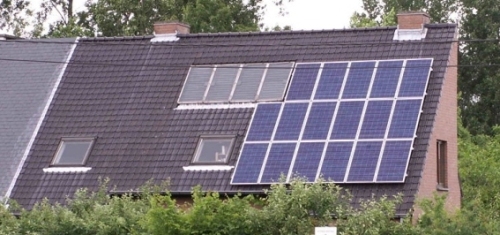Feed-in tariffs: another romantic delusion
 |
| German house with solar panels. Image source: ecolectic.org. |
As with other great popular causes, such as improving access to public libraries, reducing the use of plastic bags, and the protection of urban hedgehogs, everybody is in favour of ‘feed-in tariffs’ for renewable energy. Widely used in other parts of Europe, these tariffs guarantee a high price for every unit of electricity exported to the grid from very small generating stations. Put some solar panels on your roof in Germany and you get paid 40p for every kilowatt hour that you produce and don’t use yourself.
***
The UK micro-renewables industry raised a cheer last week as the cabinet minister newly responsible for climate change gave the thumbs up to the idea of copying our European friends and improving the financial returns for electricity generation on the smallest scale. Ed Miliband appeared to promise to amend the climate change bill to force the electricity companies to buy power at elevated prices from such things as domestic wind turbines and hydro-electric generators capturing the energy in babbling streams. The idea is that this will increase the incentives for people to install small-scale renewable electricity systems.
I have to declare an interest. My battery of photovoltaic cells sends about 500 kilowatt hours (usually known as ‘units’ in Britain) back the wrong way up the wires every year. The rest of their somewhat unimpressive output is gobbled up in the house. Any proposal that increases the price I get from the electricity company will help defray the recent unprecedented jumps in energy prices. So I ought to be in favour. But despite the clear financial incentive, and the risk of being savaged on the street by right-thinking environmentalists, I have to admit that I think that feed-in tariffs are one of the most mistaken ideas ever to worm their way into UK law. Nothing better demonstrates the vacuity of the climate change debate in the UK than the unthinking obeisance to the romantic idea of paying people money to generate tiny quantities of electricity on their back roofs.
The problem is a simple one. Micro-renewables are hugely expensive for every unit of electricity that they produce. The best example is the subsidy that the Germans generously give to solar photovoltaic installations in their cloudy country. Their feed-in tariff for solar power has been highly successful in expanding the number of homes, cowsheds, and office blocks that carry photovoltaic panels. But the cost is horrendous. Last year the Germans paid almost €1.9bn (about £1.5bn) to panel owners for their electricity. This bought about 0.6% of all the electricity that the country needed. The cost per megawatt hour was about six times the price paid for all types of electricity. The German government is gradually reducing the subsidies but their solar feed-in tariffs currently cost each householder about £40 a year. This may not seem a huge amount but as solar energy expands, the cost will get increasingly onerous.
It is true that solar power saves carbon emissions. The German solar tariff cut emissions by over 2m tonnes last year. But the cost was over £600 per tonne of CO2, or thirty times the current international price of carbon. Small-scale solar photovoltaic technologies are a truly terrible way of reducing emissions in sun-starved northern Europe. And micro-wind is unlikely to be much better except on tall buildings at the top of hills near to Scottish or Welsh coastlines.
To make a significant difference to the carbon emissions from electricity production, the UK needs to invest in tens of thousands of commercial-scale wind farms and find a way of cheaply capturing wave and tidal energy in the turbulent waters off our coasts. Done with vigour and good sense, we can hope to generate 20 or 30% of our electricity this way. We have to invest in gigantic projects like the London Array, a 300-turbine wind farm off the Kent coast. Feed-in tariffs are an expensive distraction that will do nothing to reduce UK emissions and its dangerous dependency on Russian gas.
We don’t even know what bribes the government proposes to offer the middle classes to give over some of their south-facing roofs to solar panels. Curiously, even the renewable industry body that has so successfully lobbied Ed Miliband declined to tell me that it thought the feed-in rate should be. Perhaps it is frightened that the Daily Mail will calculate how much electricity prices will have to rise to pay for the solar subsidy. My estimate is that to make photovoltaic panels a good financial investment for a UK householder, the feed-in tariffs probably need to be about 50p per unit, or possibly even more. I will certainly welcome the annual cheque from my electricity supplier but the impact on carbon emissions of even a massive expansion in UK domestic solar or wind installations will be utterly trivial.
The UK has one of the lowest percentages of renewable electricity in Europe. We could spend a billion pounds a year on subsidising solar panels and we would get barely half a percentage of our electricity from them. The UK would then be even further behind other countries. We don’t need feed-in tariffs; we need massive programmes of investment in research and development into low-carbon electricity, huge prizes for successful entrepreneurs, and participation in the global endeavour to find cheap forms of carbon capture at power stations.